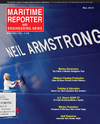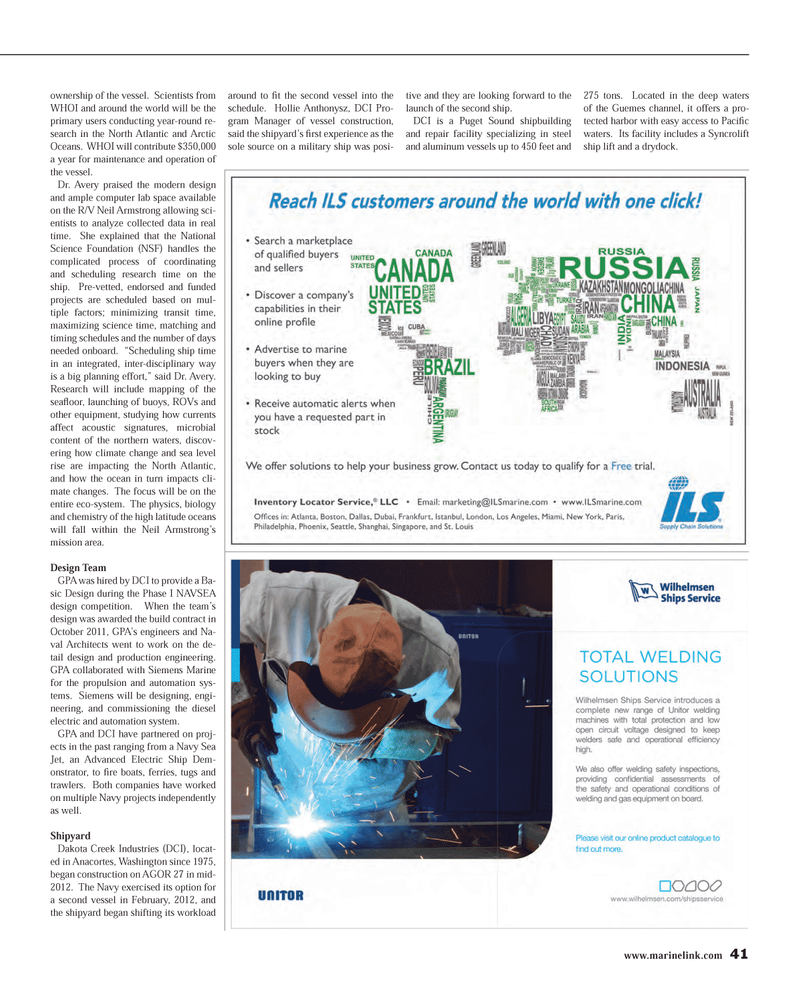
Page 41: of Maritime Reporter Magazine (May 2014)
Marine Electronics Edition
Read this page in Pdf, Flash or Html5 edition of May 2014 Maritime Reporter Magazine
www.marinelink.com 41 ownership of the vessel. Scientists from
WHOI and around the world will be the primary users conducting year-round re- search in the North Atlantic and Arctic
Oceans. WHOI will contribute $350,000 a year for maintenance and operation of the vessel.
Dr. Avery praised the modern design and ample computer lab space available on the R/V Neil Armstrong allowing sci- entists to analyze collected data in real time. She explained that the National
Science Foundation (NSF) handles the complicated process of coordinating and scheduling research time on the ship. Pre-vetted, endorsed and funded projects are scheduled based on mul- tiple factors; minimizing transit time, maximizing science time, matching and timing schedules and the number of days needed onboard. “Scheduling ship time in an integrated, inter-disciplinary way is a big planning effort,” said Dr. Avery.
Research will include mapping of the seafl oor, launching of buoys, ROVs and other equipment, studying how currents affect acoustic signatures, microbial content of the northern waters, discov- ering how climate change and sea level rise are impacting the North Atlantic, and how the ocean in turn impacts cli- mate changes. The focus will be on the entire eco-system. The physics, biology and chemistry of the high latitude oceans will fall within the Neil Armstrong’s mission area.
Design Team
GPA was hired by DCI to provide a Ba- sic Design during the Phase I NAVSEA design competition. When the team’s design was awarded the build contract in
October 2011, GPA’s engineers and Na- val Architects went to work on the de- tail design and production engineering.
GPA collaborated with Siemens Marine for the propulsion and automation sys- tems. Siemens will be designing, engi- neering, and commissioning the diesel electric and automation system.
GPA and DCI have partnered on proj- ects in the past ranging from a Navy Sea
Jet, an Advanced Electric Ship Dem- onstrator, to fi re boats, ferries, tugs and trawlers. Both companies have worked on multiple Navy projects independently as well.
Shipyard
Dakota Creek Industries (DCI), locat- ed in Anacortes, Washington since 1975, began construction on AGOR 27 in mid- 2012. The Navy exercised its option for a second vessel in February, 2012, and the shipyard began shifting its workload around to fi t the second vessel into the schedule. Hollie Anthonysz, DCI Pro- gram Manager of vessel construction, said the shipyard’s fi rst experience as the sole source on a military ship was posi- tive and they are looking forward to the launch of the second ship.
DCI is a Puget Sound shipbuilding and repair facility specializing in steel and aluminum vessels up to 450 feet and 275 tons. Located in the deep waters of the Guemes channel, it offers a pro- tected harbor with easy access to Pacifi c waters. Its facility includes a Syncrolift ship lift and a drydock.
MR #5 (32-41).indd 41 5/1/2014 3:26:04 PM

 40
40

 42
42
